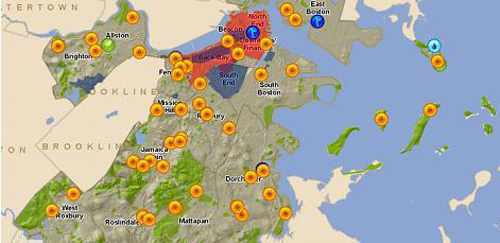On March 10, 2009, Natural Resources Canada, CanmetENERGY hosted a symposium entitled Community Energy Planning in Canada: the Value of Energy Mapping. The session was attended by members of the federal and municipal government, NGOs, industry representatives, and academic representatives who contributed their leadership, knowledge and commitment in the area of energy mapping and planning. The purpose of the session was to assess the potential application for energy mapping and encourage knowledge exchange about the potential role of the federal government in deploying energy mapping across Canada.
Below you can read the complete executive summary of the symposium final report.
Executive Summary:
Community Energy Planning in Canada: the Value of Energy Mapping Symposium, March 10, 2009.
On March 10, 2009, Natural Resources Canada, CanmetENERGY hosted a symposium entitled Community Energy Planning in Canada: the Value of Energy Mapping. The session was attended by members of the federal and municipal government, NGOs, industry representatives, and academic representatives who contributed their leadership, knowledge and commitment in the area of energy mapping and planning. The purpose of the session was to assess the potential application for energy mapping and encourage knowledge exchange about the potential role of the federal government in deploying energy mapping across Canada. Participants were welcomed by François Dubrous of CanmetENERGY and were given an overview of the expectations for the session by Brent Gilmour with the Canadian Urban Institute.
The morning session included presentations from federal staff, Geographic Information System (GIS) specialists, and industry experts from across Canada, the United States, Austria and New Zealand. Claude LeFrançois of the Office of Energy Efficiency, Natural Resources Canada reviewed the Community Energy Solutions Roadmap currently being developed for the Council of Energy Ministers. This policy document is directed at the potential role of federal, provincial and municipal governments to achieve energy efficiency improvements and reduce greenhouse gas emissions. Juan Carlos Molina with the Canadian Urban Institute presented a brief summary of how Geographic Information Systems (GIS) can be used in energy planning and provided some examples from around the world for the application of energy mapping.
Helmut Strassler of the SIR-Salzburg Institute for Regional Planning and Housing in Salzburg, Austria presented on current European initiatives and programs in energy mapping and focused on the capacity of GIS to contribute to municipal energy planning and renewable resource assessment. This was followed by a presentation from Brad Swing, Boston Mayor’s Office of Environmental and Energy Services City of Boston about the development of an on-line interactive solar mapping initiative. Brad identified the potential for replicating the initiative in Canada and emphasized the importance of partnering with utilities. Dr. Alexandre Pavlovski with Green Power Labs Inc. reviewed the solar energy mapping initiative for Dalhousie University Campus and discussed the importance of using an energy mapping hierarchy at the regional, local and site level to make informed decisions.
John Warren of the Canadian Urban Institute talked about the extensive energy mapping approach that was created for the City of Calgary. He reviewed how the study undertook to prepare a comprehensive land-use and energy tracking model that involved base-lining all energy consumed for every building in the city and working closely with municipal staff to forecast the amount of built form required to accommodate the expected growth in people and employment. The process involved developing a realistic model of what Calgary’s physical form might look like in the future in terms of the number and type of buildings, as well as their size, height and location. This information was used to prepare scenarios and maps to evaluate appropriate alternative energy sources for use in the city and where they might be located.

Screenshot of the Boston Solar GIS
To request the full document please contact us.